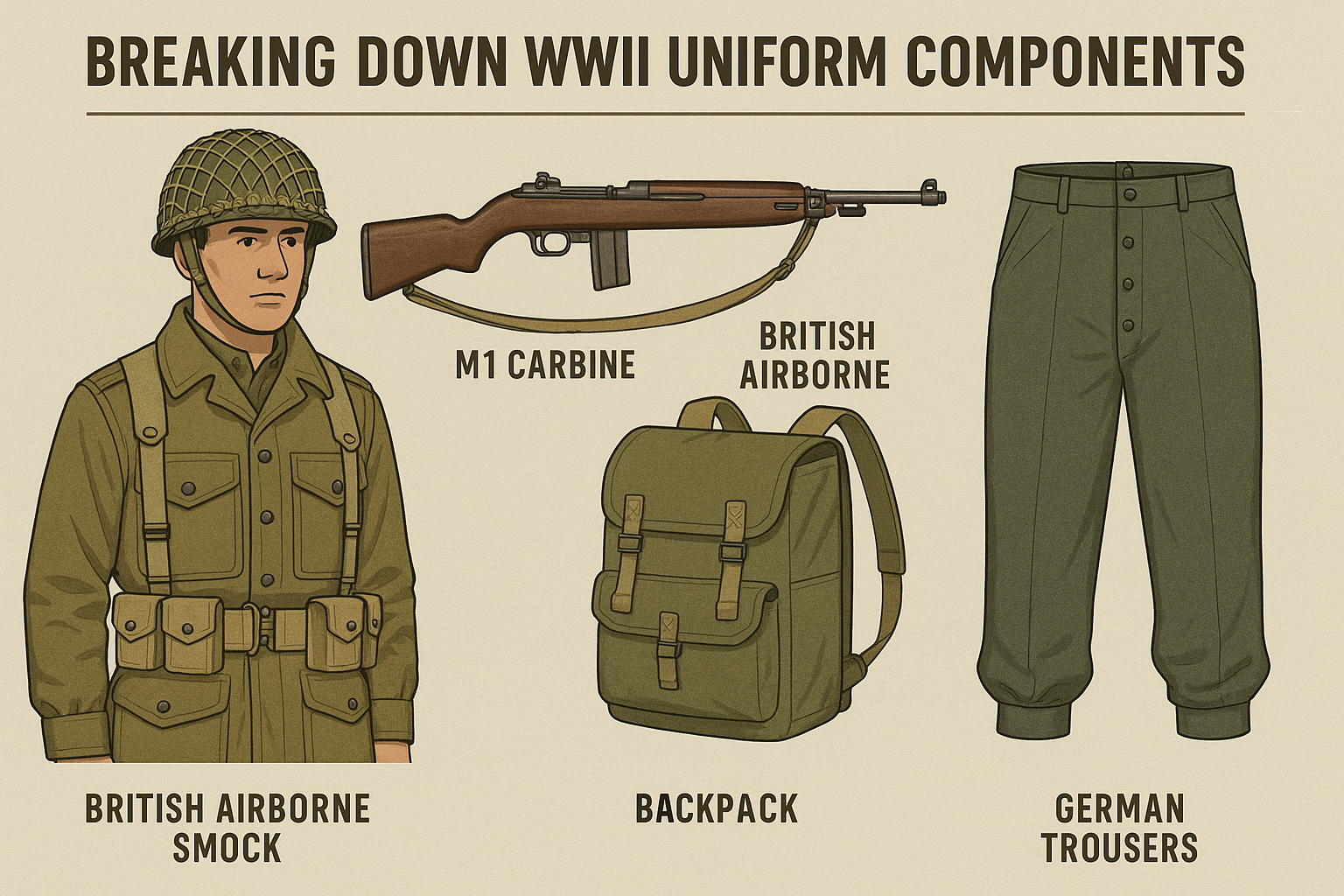
Breaking Down WWII Uniform Components: From British Airborne Gear to German Trousers
Published on May 21, 2025
Uniform Components of WWII: British Airborne, Paratroopers & Axis Gear
World War II was not only a conflict of strategies and weaponry but also of uniform innovation. Every thread, button, and strap served a purpose—whether it was to provide warmth in harsh winters, store equipment on the go, or blend into the battlefield environment.
In this article, we’ll examine WWII uniform components, focusing on the iconic gear worn by British airborne troops, their parachute units, and the WWII trousers that helped define a generation of soldiers. We'll also compare them with German trousers, showcasing how both sides approached functionality and style.
1. Introduction to WWII Uniform Components
Uniforms during WWII uniform weren’t designed with fashion in mind; they were engineered for utility, adaptability, and survival. The core components typically included:
- Headgear (helmets, berets, caps)
- Jackets or Smocks
- Trousers or Pants
- Boots and Gaiters
- Webbing and Gear Harnesses
While each Allied and Axis nation had its own military uniform philosophy, the British Airborne Forces in particular stood out for their specialized gear. Their parachute deployments and special operations demanded unique features and rugged uniform components.
2. British Airborne Uniform: Elite Gear for Elite Troops
The British Airborne Division, including the Parachute Regiment, was formed during WWII to carry out fast, mobile attacks behind enemy lines. Their uniforms reflected the extreme conditions and challenges of airborne warfare.
Key Components of British WW2 Parachute Uniforms:
- Denison Smock: A camouflaged jacket with a half-zip front and reinforced elbows. It was worn over other clothing to break up the outline of the soldier.
- Airborne Helmet: Heavier and more padded than regular British helmets to protect paratroopers during drops.
- WW2 Pants (Jump Trousers): Often baggy with reinforced knees and extra pockets for carrying maps, grenades, and gear.
- Wool Undergarments: Including WW2 wool trousers, worn beneath the jump pants in cold weather.
British airborne troops needed freedom of movement and protection from the elements. Their trousers were functional, with button fly closures, adjustable waist tabs, and plenty of room for layering.
3. WWII Pants: The Unsung Hero of Uniforms
WW2 pants were perhaps the most underestimated uniform component. They had to endure mud, snow, desert heat, and everything in between. The British, American, and German armies all produced variations of durable, utilitarian trousers.
British WWII Pants
British-issued trousers were typically high-waisted and made from thick wool serge. Designed for both infantry and airborne units, they included:
- WW2 Wool Trousers: Essential in Europe’s colder climates, these trousers provided insulation and breathability.
- Gaiters or Puttees: Often worn over the ankles to protect lower legs and keep debris out of boots.
- Cargo Pockets: For carrying essentials such as maps, rations, and tools.
Why wool? Wool resists wind, retains heat even when wet, and doesn’t ignite easily—making it ideal for field conditions.
4. German Trousers: Precision and Utility
German uniform design during WWII was known for its structure and efficiency. The German trousers, or "Hosen," were built to complement the iconic Feldbluse (field blouse).
Common Features of German WWII Trousers:
- Stone Grey or Field Grey Color: Designed to blend with European terrain.
- Button Fly and Cinch Back: Allowed for better fit without belts.
- Reinforced Knees: Especially in late-war models, for prolonged crawling or kneeling.
- Wool or Gabardine Fabric: Tough, slightly water-resistant, and less likely to shrink.
Some German troops, such as Fallschirmjäger (paratroopers), wore splinter-pattern camo trousers with extra thigh pockets, riveted stress points, and ankle drawstrings.
5. Comparing British vs German WWII Trousers
FeatureBritish WW2 Wool TrousersGerman WWII TrousersMaterial | Heavy wool serge | Wool, gabardine, or cotton
Color | Brown/Khaki | Field grey/stone grey
Design | High-waisted, flat front | Slightly tapered, cinch back
Pockets | Side slit and back pockets | Side, back, sometimes thigh
Purpose | Versatile, often layered | Precision-cut for neatness
Durability | High in cold/wet conditions | High in all terrains
6. The Modern Collector’s Guide to WWII Uniform Components
For reenactors, historians, or costume designers, accurate reproduction of uniform components is essential. Whether you’re interested in British airborne kits or seeking rare WW2 wool trousers, authenticity lies in the details.
Tips for Finding Quality Reproductions:
- Check Stitching and Fabric Weight: Authentic trousers are thick, durable, and well-stitched.
- Research the Time Period: Early-war vs. late-war styles varied significantly.
- Buy from Specialist Retailers: Sites like Paddelaters.com offer battle-tested replicas of real military patterns.
- Look for Reenactor Reviews: Experienced collectors often share detailed insights on forums and review sections.
7. Why Uniform Components Still Matter Today
Uniforms carry history, strategy, and emotion in every fiber. Understanding the components—especially something as simple as WW2 trousers—connects us to the past.
Modern Uses:
- Military Reenactments
- Film & Television Props
- Museum Displays
- Collectors and Military Enthusiasts
- Educational Resources for Students
A pair of well-made German trousers or British parachute pants isn't just clothing—it's a story from the battlefield.
Conclusion: Stitching Together the Past
World War II uniforms were complex systems of function, survival, and national identity. From the woolen warmth of WW2 trousers to the strategic structure of British airborne gear, every component had a role to play.
Whether you’re building a reenactment kit, collecting historical gear, or simply fascinated by military history, understanding the components of WWII uniforms is key to appreciating their legacy.
Explore the full range of authentic British and German WWII trousers, uniforms, and accessories at Paddelaters.com. History is better when you wear it right.
